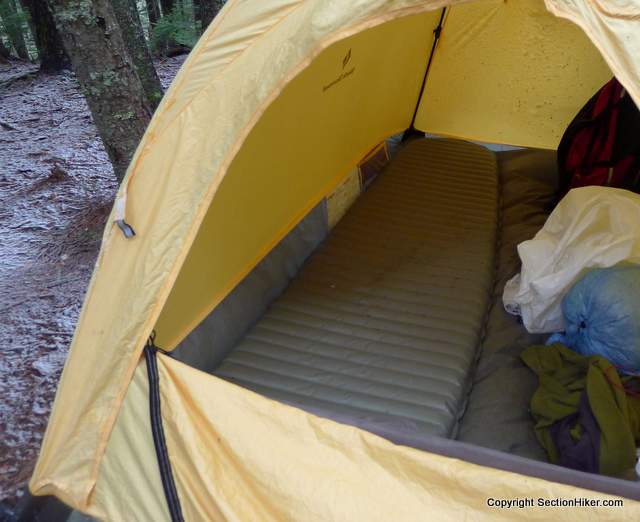
Camping and backpacking sleeping pads have R-values that measure how much insulation they provide against the cold ground. Sleeping pads designed for cold weather use have high R-values while ones designed for warmer weather have low ones. This is illustrated in this table which shows the R-values recommended for different nighttime air temperatures.
| Air Temperature (F): | 50 | 30 | 25 | 10 | 0 | -15 | -25 | -40 |
| Minimum R-Value | 1 | 2 | 3 | 4 | 5 | 6 | 7 | 8 |
| Air Temperature (C): | 10 | -1 | -4 | -12 | -18 | -26 | -32 | -40 |
| Minimum R-Value | 1 | 2 | 3 | 4 | 5 | 6 | 7 | 8 |
If you only camp in temperatures above freezing, a sleeping pad with an R-value of 2 or 3 will be sufficient. But what happens if you buy a sleeping pad with a higher R-value for winter camping, like a Thermarest NeoAir XTherm which has an R-value of 6.9. Could you use it in warmer temperatures and without overheating and sweating all night?
To answer this question (originally posed by a reader), I reached out to my technical contacts at Thermarest because they have an elaborate in-house temperature testing facility for sleeping pads and sleeping bags. I knew they’d provide me with an answer based on data, not conjecture because they’re all engineering nerds. Got to love outdoor nerds.
I asked Brandon Bowers, who’s the category manager for sleeping pads, whether you could use an XTherm for camping in hot weather. He told me “Using a high r-value pad in summer is a strategy some people use so they can eliminate the need for multiple sleep pads. I would not recommend this if nighttime temps are above 75 degrees, but this is a personal preference.”
While there are bound to be individual differences with that threshold, it provides a good baseline to help minimize the amount of money you spend on sleeping pads if you plan to camp in summer and winter. Take me, for example: I avoid winter camping in temperatures below zero because it’s just no fun freezing your ass off outside below that when melting snow for drinking water, which can take a while. Zero degrees, no problem. But I’m over camping in really extreme cold.
If you’re like me and zero degrees is the coldest winter weather you want to gear up for, rather than buying a NeoAir XTherm (R=6.9), you’d be better off buying a Thermarest NeoAir XLite (R=4.2) for three-season use and stacking it with an inexpensive Thermarest Zlite Sol foam pad (R=2), for winter use (4.2+2=R6.2), since R-values are additive. You can even use an inflatable sleeping pad with an R=3 rating and a foam pad. You always want to carry a foam pad in winter anyway, so you have insulation to sit on while you’re cooking and melting snow or for an emergency.
In hot summer weather, you’ll probably be fine with the XLite up to nighttime temps of 85 degrees (F) or so. If you do combine the XLite and ZLite for winter, you wouldn’t have to buy an XTherm at all because it’s really only good for very cold weather use and not for summer temperatures.
I guess that is kind of a nerdy analysis. I’ll probably be selling my XTherm soon.
SectionHiker is reader-supported. We independently research, test, and rate the best products. We only make money if you purchase a product through our affiliate links. Help us continue to test and write unsponsored and independent gear reviews, beginner FAQs, and free hiking guides.

